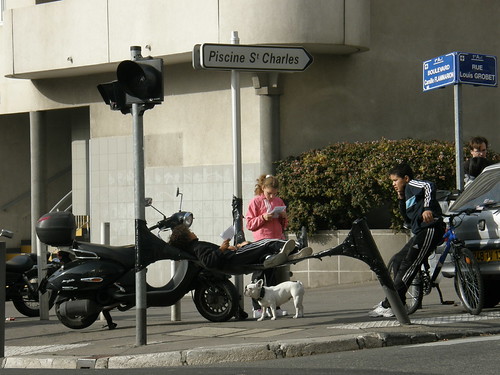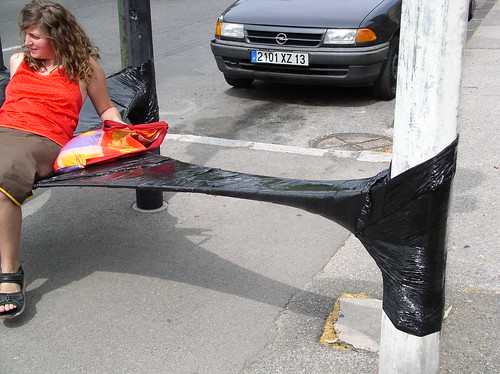 "Ornament is a crime" wrote Adolph Loos in 1908. This sentence was opening one century of disdain for architecture's aesthetic developed by modernism. A hundred years later, a School claims for an embrace of ornament via computation. This approach of architecture is highly debatable since it seems to fully accept the role of the architect as only a embroiderer who would be able to express his creativity in non-essential elements (just like the French law which plans that 1% of every public building's budget should be dedicated to a piece of art).
"Ornament is a crime" wrote Adolph Loos in 1908. This sentence was opening one century of disdain for architecture's aesthetic developed by modernism. A hundred years later, a School claims for an embrace of ornament via computation. This approach of architecture is highly debatable since it seems to fully accept the role of the architect as only a embroiderer who would be able to express his creativity in non-essential elements (just like the French law which plans that 1% of every public building's budget should be dedicated to a piece of art).However, some people succeeds to design ornaments as fully part of the narration expressed by a project. Computation allows them then to populate a structure with an expressive ornamentation that register the resulting architecture in what we could call neo-baroque. Architecture becomes thus a materialized surrounding narration and computer seems essential to have a global and local control of the project (capitalism not allowing the construction to take as much time as it used to do in the 17th century during the baroque era).
Tobias Klein, former student at the Bartlett and now teaching at the Royal College of Arts, the Architectural Association and one of the founders of an experimental design group called horhizon, is one of this rare people. His two projects, Synthetic Syncretism and Contour Embodiment and the project developed by one of his student, Jordan Hodgson at the RCA are examples of fascinating narrations embodied by their neo-baroque architecture.
Synthetic Syncretism by Tobias Klein
The project’s narrative background is based upon the hybrid Cuban religion of Santeria (a mixture between Catholicism and the African Yoruba tribe beliefs). As a result of this unusual syncretism an altered kind of religion evolved which hybridizes Catholic Saints with animals and Sakralraum with sacrifices.
The necropolis Christobal Colon, the main cemetery, does not provide enough burial space hence the proposal for a processional route through the city of Havana for a ceremonial funeral in the sea. Along this processional route the ‘Chapel of Our Lady de Regla’ acts as architectural highlight.
Slotted inside an existing cross shaped courtyard, this inverted chapel contains a series of Santerian relics and utensils condensed from the virtual into the actual. Tweaked to the max, skeleteral and visceral at the same time, these ‘cybrid’ objects, 3D modeled and 3D printed in order to perfectly fit animal bones found on the site in Cuba, and 3D scanned into virtuality and re-moulded into actuality in London, provide, on a smaller scale, the formal expression for the larger architectural intervention.
At face value computer-aided architectural design (CAAD) merely performs within the domain of what is best described by the German term Technik (it expresses technology, technic and technique). Thetruth is that CAAD overcomes the dichotomy between technē (craftsmanship) and poiēsis (art).
Although digitally driven, the project does not succumb to the pervasive allurement of ‘Parametric Digital Modernism’—the unspecified whitewash (actually grey) of =3D surfaces, the universal Sachlichkeit of algorithmic design techniques, and the mechanistic vision of input-output interactivity.
The project provides an example of syncretism of contemporary CAD techniques and CAM
technologies with site specific design narratives, intuitive non-linear design processes, and historical architectural references. The project shows the architect as the creator-craftsman that finally has the chance to overcome the fifteenth- and sixteenth-century schism of intellectual from manual labour, as well as the nineteenth-century gulf between automatic mechanisation and poetic creation.
The necropolis Christobal Colon, the main cemetery, does not provide enough burial space hence the proposal for a processional route through the city of Havana for a ceremonial funeral in the sea. Along this processional route the ‘Chapel of Our Lady de Regla’ acts as architectural highlight.
Slotted inside an existing cross shaped courtyard, this inverted chapel contains a series of Santerian relics and utensils condensed from the virtual into the actual. Tweaked to the max, skeleteral and visceral at the same time, these ‘cybrid’ objects, 3D modeled and 3D printed in order to perfectly fit animal bones found on the site in Cuba, and 3D scanned into virtuality and re-moulded into actuality in London, provide, on a smaller scale, the formal expression for the larger architectural intervention.
At face value computer-aided architectural design (CAAD) merely performs within the domain of what is best described by the German term Technik (it expresses technology, technic and technique). Thetruth is that CAAD overcomes the dichotomy between technē (craftsmanship) and poiēsis (art).
Although digitally driven, the project does not succumb to the pervasive allurement of ‘Parametric Digital Modernism’—the unspecified whitewash (actually grey) of =3D surfaces, the universal Sachlichkeit of algorithmic design techniques, and the mechanistic vision of input-output interactivity.
The project provides an example of syncretism of contemporary CAD techniques and CAM
technologies with site specific design narratives, intuitive non-linear design processes, and historical architectural references. The project shows the architect as the creator-craftsman that finally has the chance to overcome the fifteenth- and sixteenth-century schism of intellectual from manual labour, as well as the nineteenth-century gulf between automatic mechanisation and poetic creation.









Contour Embodiment by Tobias Klein and Ben Cowd
On a tectonic level, the project amalgamates symbiotically the qualities of contoured geometries (Ben Cowd) and volumetric voluptuous embodiment of MRI generated organs(Tobias Klein). On the conceptual level, the work is much guided by a fascination of catholic Iberian baroque, the scale-less implementation of symbolism of the Sacred Heart by the use of MRI generated body data; aconversation with the particular architecture of St. Paul’s cathedral by Sir Christopher Wren and the adjacent properties as constructive interpretation of the hidden spaces of the double dome /cone lighting qualities within St. Paul.


Workhouse of the Infrastructural [Counter] Reformation by Jordan Hodgson
‘Inequality has reached Victorian levels’
'Britain has the lowest level of social mobility in the developed world.'
(July 2008 - Shadow Minster Chris Grayling)
By 2032 the chaotic urban conditions that once helped define Elephant and Castle have given rise to a cripplingly disenfranchised underclass. In this bleak landscape of proletariat discontent, might the British government revert back to Victorian modes of jurisdiction, whilst simultaneously providing an architectural placebo to soothe a nervous population?
Unprecedented levels of unemployment generated by the crash of 2008, combined with a paralysis of social mobility triggers the reinauguration of the once potent Workhouse typology. A re-branded Victorian-style workhouse, reminiscent of a lost empire, provides a sanctuary for adrift individuals and the crucial workforce required for a British industrial renaissance. The lost industries of the golden age are reawakened from decades of slumber and manifested in a glorified cathedral to the plebeians of Elephant and Castle.
Car manufacturing and living quarters are positioned uncomfortably adjacent to bureaucratic authority, with a constitution of rationality, efficiency and profit permeating throughout. A sprawling workhouse, providing a clear separation between its occupants and the population of Elephant and Castle at large, gradually inhabits the infrastructurally intensified cityscape. A language of sublime ornament and excess exerts a sense of authoritative power over the workers, but a gain in momentum sees the emergence of an architectural encrustation that quite literally embodies the paupers that it controls.
'Britain has the lowest level of social mobility in the developed world.'
(July 2008 - Shadow Minster Chris Grayling)
By 2032 the chaotic urban conditions that once helped define Elephant and Castle have given rise to a cripplingly disenfranchised underclass. In this bleak landscape of proletariat discontent, might the British government revert back to Victorian modes of jurisdiction, whilst simultaneously providing an architectural placebo to soothe a nervous population?
Unprecedented levels of unemployment generated by the crash of 2008, combined with a paralysis of social mobility triggers the reinauguration of the once potent Workhouse typology. A re-branded Victorian-style workhouse, reminiscent of a lost empire, provides a sanctuary for adrift individuals and the crucial workforce required for a British industrial renaissance. The lost industries of the golden age are reawakened from decades of slumber and manifested in a glorified cathedral to the plebeians of Elephant and Castle.
Car manufacturing and living quarters are positioned uncomfortably adjacent to bureaucratic authority, with a constitution of rationality, efficiency and profit permeating throughout. A sprawling workhouse, providing a clear separation between its occupants and the population of Elephant and Castle at large, gradually inhabits the infrastructurally intensified cityscape. A language of sublime ornament and excess exerts a sense of authoritative power over the workers, but a gain in momentum sees the emergence of an architectural encrustation that quite literally embodies the paupers that it controls.





































